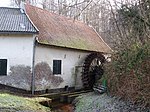NATO Air Base Geilenkirchen
Airports in North Rhine-WestphaliaGerman airbasesHeinsberg (district)NATO installations in GermanyPortal templates with redlinked portals

NATO Air Base Geilenkirchen (E-3A Component) (IATA: GKE, ICAO: ETNG) is located near Geilenkirchen, North Rhine-Westphalia, Germany. It is the main operating base of the NATO Boeing E-3 Sentry Component, one of two operational elements of the NATO Airborne Early Warning & Control Force.
Excerpt from the Wikipedia article NATO Air Base Geilenkirchen (License: CC BY-SA 3.0, Authors, Images).NATO Air Base Geilenkirchen
Panneschopp,
Geographical coordinates (GPS) Address Nearby Places Show on map
Geographical coordinates (GPS)
| Latitude | Longitude |
|---|---|
| N 50.960833333333 ° | E 6.0425 ° |
Address
NATO E-3A Airbase Geilenkirchen
Panneschopp
52511
North Rhine-Westphalia, Germany
Open on Google Maps







